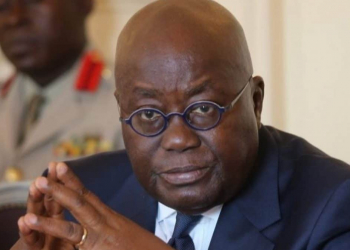The chairman of the Monetary Policy Committee of the Bank of Ghana (BoG), Dr. Abdul-Nashiru Issahaku, has expressed worry over the current level of inflation, warning that it is still high compared to the medium term target.
Speaking Monday after concluding the Central Bank’s 72nd regular MPC meetings, he said per the assessment of the current economic conditions, the Committee observed some moderations in headline inflation since its July meeting on the back of continued Cedi stability, easing inflation pressures and tight credit conditions.
These, according to him, implicitly reflect continued monetary policy tightness and that together with projections of tighter fiscal consolidation and lower growth, contributed to inward shift in the forecast horizon from the third quarter to the second of 2017.
Notwithstanding these gains, Dr. Issahaku said, current levels of inflation are still not the best and that in the light of the assessment, the committee decided to retain the monetary policy rate at 26percent.
The Committee, he assured, will continue to monitor developments in the economy and take appropriate actions, if necessary, towards attaining the medium-term inflation target over the forecast horizon.
The next Monetary Policy Committee (MPC) meeting is scheduled for Friday, November 18, 2016.
Bellow is the Highlights of the 72ND MPC meeting:
Ladies and Gentlemen, welcome to this MPC press briefing. We have concluded our 72ndregular MPC meetings, and I present to you highlights of the deliberations and the Committee’s decision.
Price developments since the last MPC show that headline inflation which stood at 18.4 percent in June, declined to 16.7 percent in July, before edging up to 16.9 percent in August 2016. The slowdown in July was largely attributed to base effects from non-food inflation which fell by2.9 percentage points to 21.2 percent while food inflation remained virtually unchanged. In August, inflation inched up, again due to base effects arising from a downward revision in petroleum products a year earlier. However, the Bank’s measure of Core inflation (CPI inflation excluding energy and utility prices), which reflects underlying inflation, continued to trend downwards. Inflation expectations by businesses, consumers and the financial sector also eased on the back of continued stability in the local currency.
Despite the decline from a peak of 19.2 percent in March 2016, headline inflation still remains high relative to the medium-term target band of 8±2 percent. At this MPC meeting, the inflation forecast showed a slight inward shift in the horizon to the second quarter, instead of the third quarter of 2017. Going forward, the continued monetary and fiscal policy tightness, together with stability in the foreign exchange market should support the disinflation process. The upside risks to the inflation outlook are the unanticipated shocks, especially with regards to the intermittent upward adjustments in petroleum and utility prices, and their second round effects.
The updated Composite Index of Economic Activity (CIEA) for July 2016 reflected an increased pace of growth relative to same period in 2015. The key indicators which contributed to the pickup in economic activity were port activities and industrial consumption of electricity. In the latest surveys, business and consumer sentiments on the economy were mixed. While consumers expressed optimism, business perceptions about the general economic situation were modest due to their unrealized expectations.
Growth conditions are expected to improve over the medium-term supported by the sustained improvement in the power sector and increased oil and gas production. However, the headwinds to growth include tighter fiscal consolidation, declining private sector credit and delayed recovery in commodity prices.
Provisional data on execution of the government budget for the first half of 2016 showed a deficit of 3.1 percent of GDP, against a target of 2.6 percent. The higher than programmed deficit was primarily driven by shortfalls from income and property taxes and oil revenue. However, government expenditures were broadly contained. The deficit was financed mostly from domestic sources that included a drawdown on government deposits with the central bank.
The major risks to the fiscal outlook include uncertainties in the international oil market, continued weakness in tax revenue mobilisation and wage pressures. The materialisation of these risks could slowthe pace of fiscal consolidation and hinder efforts to restore macroeconomic stability. Sustaining the fiscal consolidation process is therefore critical to attaining the medium-term inflation target.
According to the IMF’s July World Economic Outlook, global growth prospects have weakened further following the UK vote to leave the EU. In addition to the lower growth forecasts, there are expectations of sustained low and negative interest rates across global financial markets, while the U. S. Fed inches closer to a year-end rate hike. These developments could have implications for Ghana’s balance of payments.
In the first half of 2016, the external trade deficit widened on account of lower export receipts, especially for crude oil. However, its overall effect on the current account balance was moderated by lower outflows from the services account. The provisional outturn of the current account balance therefore improved to a deficit of 2.6 percent of GDP, compared with 2.8 percent in the same period of 2015.
The local currency has been relatively stable since the beginning of the year. In the year to September 15, 2016, the Ghana cedi cumulatively depreciated by 4.1 percent compared with 16.0 percent depreciation in the same period of 2015. This was achieved on the back of tight policy stance and improved foreign exchange flows. The stability of the currency is expected to be sustained, supported by the continued policy tightness, proceeds from the recently issued Eurobond, inflows from donors and the pre-export finance facility for cocoa.
In assessing the current economic conditions, the Committee noted the moderation in headline inflation since the July meeting on the back of continued cedi stability, easing inflation pressures, and tight credit conditions which implicitly reflect continued monetary policy tightness. This, together with projections of tighter fiscal consolidation and lower growth, contributed to the inward shift in the forecast horizon from the third quarter to the second quarter of 2017. Despite these positive developments, the Committee observed that the current level of inflation is still high compared to the medium term target.
In the light of these assessments, the Committee decided to maintain the monetary policy rate at 26 percent. The Committee will continue to monitor developments in the economy and take appropriate actions, if necessary, towards attaining the medium-term inflation target over the forecast horizon.
Sign up for Ghana Star News to receive daily email alerts of breaking news in Ghana. GhanaStar.com is your source for all Ghana News. Get the latest Ghana news, breaking news, sports, politics, entertainment and more about Ghana, Africa and beyond.


